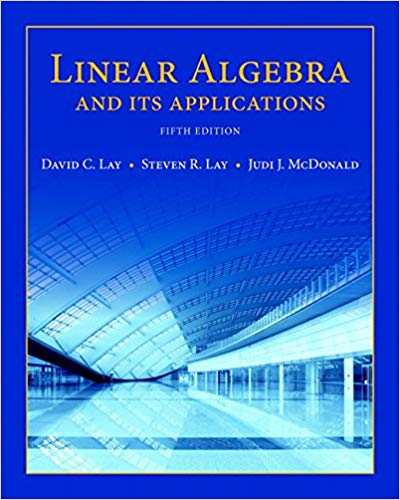
Linear Algebra and Its Applications, 5th Edition
Authors: David C. Lay, Steven R. Lay, Judi J. McDonald
ISBN-13: 978-0321982384
We have solutions for your book!
See our solution for Question 8E from Chapter 4.5 from Lay's Linear Algebra and Its Applications, 5th Edition.
Problem 8E
Chapter:
Problem:
For each subspace in Exercises 1–8, (a) find a basis for the subspace, and (b) state the dimension.
Step-by-Step Solution
Given Information
We are given with a subspace \[ \{ ( a , b , c , d ) : a - 3 b + c = 0 \} \] We have to find the basis and state the dimension
Step-1:
Write the condition in terms of $a$. \[ \begin{aligned} a - 3 b + c & = 0 \\ a & = 3 b - c \end{aligned} \] The given set can be written in the parametric form. \[ \begin{aligned} \mathbf { x } & = ( a , b , c , d ) \\ & = ( 3 b - c , b , c , d ) \\ & = ( 3 b , b , 0,0 ) + ( - c , 0 , c , 0 ) + ( 0,0,0 , d ) \\ & = b ( 3,1,0,0 ) + c ( - 1,0,1,0 ) + d ( 0,0,0,1 ) \end{aligned} \] So, the set can be written as: \[S = \left\{ {{v_1} = \left[ {\begin{array}{*{20}{c}} 3\\ 1\\ 0\\ 0 \end{array}} \right],\,{v_2} = \left[ {\begin{array}{*{20}{c}} { - 1}\\ 0\\ 1\\ 0 \end{array}} \right],\,{v_3} = \left[ {\begin{array}{*{20}{c}} { - 1}\\ 0\\ 1\\ 0 \end{array}} \right],\,} \right\}\]
Step-2: The augmented matrix
The augmented matrix for $Ax=0$ \[A = \left[ {\begin{array}{*{20}{c}} 3&{ - 1}&0\\ 1&0&0\\ 0&1&0\\ 0&0&1 \end{array}} \right]\]
Step-3: The row-reduced augmented matrix
\[\begin{array}{l} A = \left[ {\begin{array}{*{20}{c}} 3&{ - 1}&0\\ 1&0&0\\ 0&1&0\\ 0&0&1 \end{array}} \right]\\ A = \left[ {\begin{array}{*{20}{c}} 3&{ - 1}&0\\ 0&{\dfrac{1}{3}}&0\\ 0&1&0\\ 0&0&1 \end{array}} \right]::\,\,\left\{ {{R_2} = {R_2} - \dfrac{{{R_1}}}{3}} \right\}\\ A = \left[ {\begin{array}{*{20}{c}} 3&{ - 1}&0\\ 0&{\dfrac{1}{3}}&0\\ 0&0&0\\ 0&0&1 \end{array}} \right]::\,\,\left\{ {{R_3} = {R_3} - 3{R_1}} \right\} \end{array}\] There are three equations and three pivot elements, hence the vectors are linearly independent Thus the vectors form a basis for H.
The $\{ (3,1,0,0),( - 1,0,1,0),(0,0,0,1)\} $ form a basis for H
Step-4: Dimension of the basis
The dimension of the vector space is the number of non-zero vectors present in basis for vector space. Hence
The dimension of the subspace S is 3
We are given with a subspace \[ \{ ( a , b , c , d ) : a - 3 b + c = 0 \} \] We have to find the basis and state the dimension
Step-1:
Write the condition in terms of $a$. \[ \begin{aligned} a - 3 b + c & = 0 \\ a & = 3 b - c \end{aligned} \] The given set can be written in the parametric form. \[ \begin{aligned} \mathbf { x } & = ( a , b , c , d ) \\ & = ( 3 b - c , b , c , d ) \\ & = ( 3 b , b , 0,0 ) + ( - c , 0 , c , 0 ) + ( 0,0,0 , d ) \\ & = b ( 3,1,0,0 ) + c ( - 1,0,1,0 ) + d ( 0,0,0,1 ) \end{aligned} \] So, the set can be written as: \[S = \left\{ {{v_1} = \left[ {\begin{array}{*{20}{c}} 3\\ 1\\ 0\\ 0 \end{array}} \right],\,{v_2} = \left[ {\begin{array}{*{20}{c}} { - 1}\\ 0\\ 1\\ 0 \end{array}} \right],\,{v_3} = \left[ {\begin{array}{*{20}{c}} { - 1}\\ 0\\ 1\\ 0 \end{array}} \right],\,} \right\}\]
Step-2: The augmented matrix
The augmented matrix for $Ax=0$ \[A = \left[ {\begin{array}{*{20}{c}} 3&{ - 1}&0\\ 1&0&0\\ 0&1&0\\ 0&0&1 \end{array}} \right]\]
Step-3: The row-reduced augmented matrix
\[\begin{array}{l} A = \left[ {\begin{array}{*{20}{c}} 3&{ - 1}&0\\ 1&0&0\\ 0&1&0\\ 0&0&1 \end{array}} \right]\\ A = \left[ {\begin{array}{*{20}{c}} 3&{ - 1}&0\\ 0&{\dfrac{1}{3}}&0\\ 0&1&0\\ 0&0&1 \end{array}} \right]::\,\,\left\{ {{R_2} = {R_2} - \dfrac{{{R_1}}}{3}} \right\}\\ A = \left[ {\begin{array}{*{20}{c}} 3&{ - 1}&0\\ 0&{\dfrac{1}{3}}&0\\ 0&0&0\\ 0&0&1 \end{array}} \right]::\,\,\left\{ {{R_3} = {R_3} - 3{R_1}} \right\} \end{array}\] There are three equations and three pivot elements, hence the vectors are linearly independent Thus the vectors form a basis for H.
The $\{ (3,1,0,0),( - 1,0,1,0),(0,0,0,1)\} $ form a basis for H
Step-4: Dimension of the basis
The dimension of the vector space is the number of non-zero vectors present in basis for vector space. Hence
The dimension of the subspace S is 3